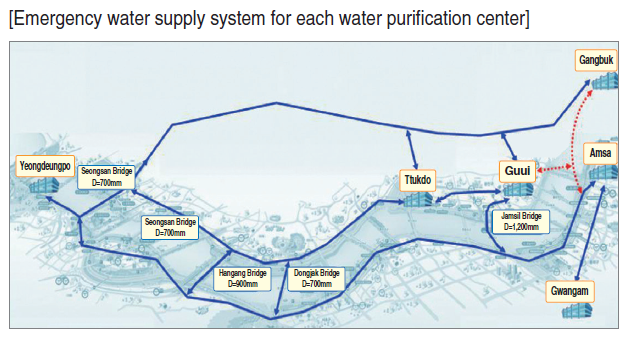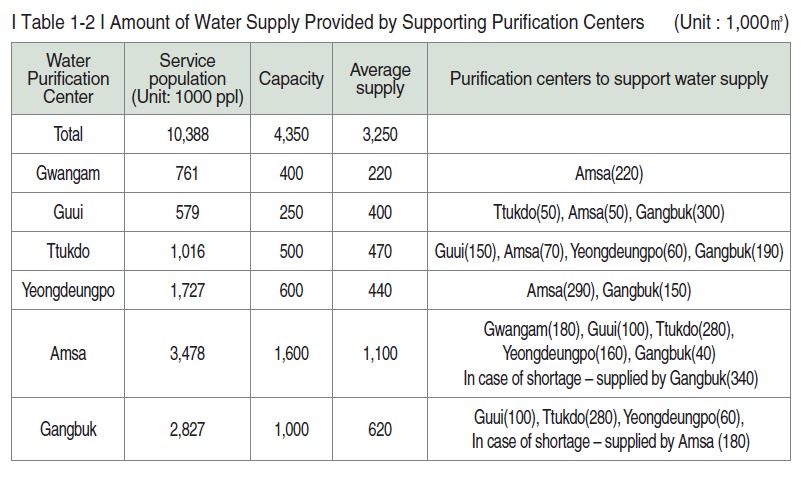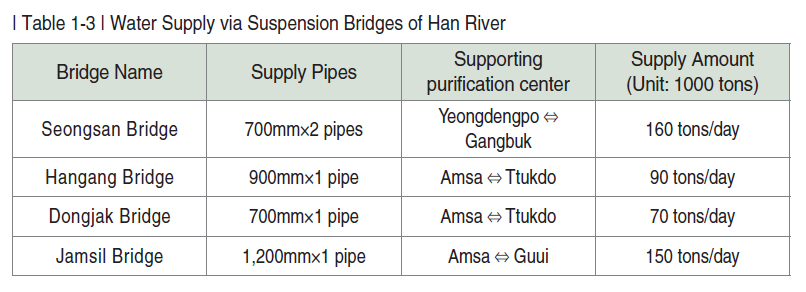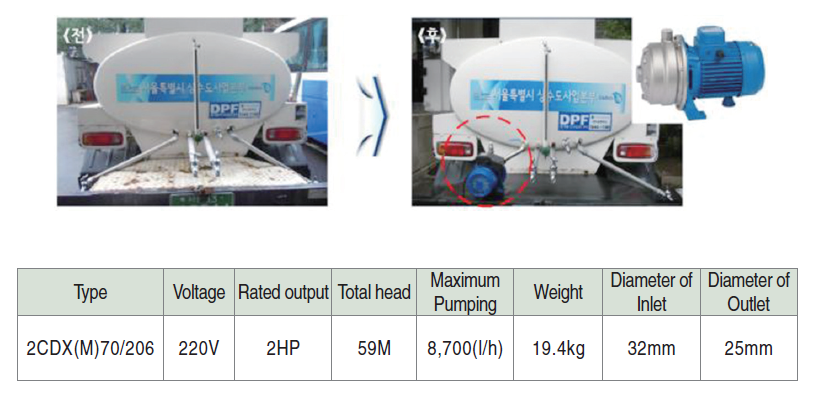Approvisionnement en eau sans interruption et système d'alimentation en eau en cas de secours
Introduction
Minimizing the impact of water supply interruptions through quick emergency response measures and adjustment of water supply system tailored to high/lowlands
Committed to providing the best water supply service to 10.39 million Seoul citizens, the Office of Waterworks of the Seoul Metropolitan Government has installed emergency water supply pipes between water purification plants and between water reservoirs, thereby eliminating the risk of water outages that may take place after leak, earthquake, or other natural disasters. In addition, we have effectively utilized the newly created suspension bridge pipelines on Han River bridges to connect the water supply networks of Gangnam and Gangbuk, making them complement one another in emergency situations.
Furthermore, to maintain the security of water supply, we have also introduced an emergency action plan with which we can rapidly alter source water in cases of isolated water outages caused by small-scale leaks.
Overview of the Policy
<< In lowlands with high water pressure, the indirect water supply system using reservoirs has replaced the direct method.
<< Emergency water pipelines are now installed to connect large-scale purification plants in Gangbuk and Amsa.
<< Tanker trucks are employed to enable water to be supplied to tall buildings
Background
Differences in water pressure due to Seoul’s topographic characteristics caused frequent water leaks
Seoul’s mountainous terrain requires pressurizing stations to supply water to higher-lying areas. Nonetheless, such pressurizing stations proved to be insufficient in preventing water interruptions. In fact, high water pressure in the lowlands continued to cause water leaks, whereas water shortages plagued many highland areas. Therefore, there was a clear need to replace the direct water supply system using pressurizing stations with an indirect system whereby water is supplied through water reservoirs.
The combined application of direct and indirect water supply systems led to energy wastage and high water pressure
While water is supplied at normal pressure level in most parts of Seoul, lowlands suffered from various water interruption issues due to higher water pressure (5.0kgf/cm3).
Of the 16,634 cases of leaks that occurred in 2010, 3,904 occurred in high water pressure areas (lands supplied with water at high pressure); this is six times higher than the areas with normal water pressure levels. Such interruptions caused 8.5 billion won in losses and much inconvenience to the residents of the affected areas/districts.
• In areas where water is supplied to both high- and low-lying areas, higher head was used to lift water uphill, causing significant energy loss.
• After emergency recovery from water leak, water was supplied to the lowlands first, causing delays of recovery in the high-lying areas.
• In areas where water was supplied directly from its source, water supply was immediately cut off when pressurizing stations failed due to power outage, causing sudden water interruptions and much inconvenience to the community.
In case of water interruptions and other emergencies, upper floors of high-rise buildings had most difficulties with water supply
Since 60% of the residents in Seoul live in apartment buildings, it was necessary to enable water supply to higher floors in the event of an emergency.
• During water interruptions, bottles of Arisu water were distributed, and water supply trucks were mobilized (only for lower floors).
Process of Policy Implementation
The indirect water supply system, instead of the direct system, is utilized for high water pressure areas
• A plan that would allow switching from direct water supply (using pressurizing stations) to indirect water supply (using reservoir) was formulated.
• A plan to change the water supply system in the Namsan reservoir was formulated.
• The Bogwang reservoir & pressurizing station around Whoam-dong and Cheonyeon pressurizing station changed their system from direct to indirect using the Namsan reservoir.
• A plan for the water flow of the Gaewoonsan reservoir was made.
• . Areas such as Jeungnung2, Seongbuk1, and Seougbuk2, which previously used pressurizing stations, now changed the system to use the indirect water distribution mechanism with a reservoir in Gaewoonsan.
• Efforts are underway to construct the water supply system for the Samsung, Bongeun, and Suseo reservoirs.
An emergency water supply system is in place, with emergency water pipes connecting large-scale purification stations in Gangbuk and Amsa
• Efforts to establish the <Basic Plan for Waterworks Improvement by 2020> began
• Emergency duct lines were installed to connect the purification stations of Gangnam and Gangbuk to ensure balance in the capacity of the stations in both regions.
• : The #2 purification plant in Yeongdeungpo was rebuilt.
• : An alternative water source was newly introduced as supply during the construction period of advanced water treatment facilities (70,000 tons/day for Gangbuk, 135,000 tons/day for Amsa).
• : The Guui purification plant was rebuilt, and an alternative source of water began to be made available during the construction period of advanced water treatment facilities.
• : The Ttukdo purification plant was rebuilt, and efforts are underway to ensure an alternative water source during the construction period of advanced water treatment facilities.
• Efforts are underway to install large-scale emergency water supply pipes connecting Gangbuk and Amsa, between different purification plants, between many reservoirs, and between the purification plant and the reservoir.
Facilities such as tanker truck are being effectively operated to supply water to high-rise buildings
• A plan to improve water supply trucks was formulated.
The plan is implemented in full-scope feasibility studies of applying pumps on trucks and pilot project as well as several meetings with service providers and internal discussions.
Introduction of the Policy
Areas with high water pressure are designated as indirect water supply service areas, taking into consideration the characteristics of each region
• Major Projects
Among 32,400 households in 11 dongs of 3 administrative districts -- Jongno-gu, Yongsangu, and Seodaemun-gu – supplied with water from the Daehyeonsan reservoir and nearby areas (Malli and Neungan reservoirs), some were reclassified to receive water from the Namsan reservoir water supply system. At least 90% of the service area covered by direct water supply will now be covered by the indirect water supply system, whereas the remaining 10% will receive water supply from pressurizing stations.
As part of the project, we closed the Malli, Cheonyeon, and Changcheon pressurizing stations and Cheonyeon and Bongwon reservoirs. As a result, the head of fluid at the Bogwang reservoir went down from 108m to 104m, enabling reduced electricity cost. In addition, we created more green spaces for the citizens by landscaping the site previously used for reservoirs and pressurizing stations.
We established a separate water supply system for different elevations (for below 30m and above 50m) to prevent water leak caused by overpressure and a two-track water supply system to ensure stable supply of water.
Service areas covered by Seongbuk 1, 2, Insoo, Jongam, and Haemyung pressurizing stations via direct water supply now receive water indirectly from the integrated Bugak tunnel pressurizing station. As a result, 3 pressurizing stations were closed down.
An emergency water supply scheme was put in place including installation of emergency water pipelines to connect large-scale purification plants in Gangbuk and Amsa
We built emergency water pipes connecting the Gangbuk and Amsa water purification centers so that each center serves as alternative source water in case of an emergency such as interruption of water supply due to the contamination of source water.
Establishing the infrastructure necessary to deploy tanker trucks for high-rise buildings
In case of emergency, water supply to the upper story of an apartment may be difficult. To address this issue, one electric booster pump (2HP, H=59m), which will be connected to the deployed water tanker for high-rise buildings, was installed for each of the water tankers owned by each Waterworks office.
Know-how & Insights
Overpressure regions were reclassified to receive water indirectly, taking into consideration the characteristics of each region.
To change the water supply source, we conducted due diligence to measure flow direction, flow velocity, and hydraulic pressure. Then, we coordinated schedules and determined the order of priority. To minimize the inconvenience experienced by the citizens, we held 10~15 meetings with interested parties and thoroughly prepared in advance.
An emergency water supply scheme that includes interconnected pipelines between large-scale purification plants in Gangbuk and Amsa was put in place.
Projects including the construction of advanced water treatment facilities in Gangbuk and large-scale water pipeline construction such as establishment of dual pipeline system for Olympic Expressway require an emergency water supply plan that includes changing the source water. Thus, we initiated simulation to measure changes in flow direction, flow velocity, and hydraulic pressure resulting from source water changes, and then utilized this data during the actual construction project. Large-scale construction projects to build and connect water pipelines require a huge budget. Therefore, the budget for these construction projects is incorporated into both “2020 Basic Plan for Waterworks Improvement” and “2030 Basic Plan for Waterworks Improvement,” and we are making full preparation to ensure smooth water supply with zero interruption rate. The successful implementation of these projects requires a large budget and a contingency plan to respond to source water changes in case of an emergency including degradation of water quality.
By installing a pump, existing water tankers can be used to supply water to high-rise buildings without reconfiguring the vehicle.
Reconfiguration of the vehicle is costly, and it is difficult to install pressurizing facilities on a par with a fire truck. Therefore, instead of changing the structure of the vehicle, we installed a pump at the rear of the tanker truck to supply water to 15-story buildings.
Policy Outcome & Evaluation
Improved water supply system: Shifted from direct supply via pressurizing pump to indirect supply via service reservoirs
Establishing an emergency water supply management system in case of emergencies such as suspension of tap water supply at the purification plants
An emergency plan to change the source of water supply -- in case of water supply interruption at some purification plants or water interruptions due to natural disasters or leak -- was put in place and implemented. To this end, we installed emergency pipelines to connect the purification plants and service reservoirs.
Building the infrastructure needed to deploy tanker trucks to supply water to high-rise buildings
It is now possible to supply water to 15-story buildings in case of water interruptions.
Applicability of the Policy
Seoul’s policy on water supply networks can be replicated in cities in Central and South America, where there are many rivers and hillsides
• Seoul can share the know-how and experience in changing water supply systems and tackling problems that may arise in the process, thereby helping cities manage a stable water supply system.
• By minimizing the use of pressurizing stations, cities that adopt Seoul’s policy can reduce energy consumption and save budget.
Q&A
What was the greatest challenge in implementing the emergency plan to ensure all-year-round, reliable supply of tap water without any water interruption?
At the initial stage, it was not easy to conduct due diligence to measure flow direction, flow velocity, and hydraulic pressure, which were needed to change the water supply system. Moreover, we faced difficulties in constructing duct lines, gate valves, and drain valves as well as changing the water supply source.
Has the emergency water supply scheme ever been utilized to supply water between purification centers?
Yes, the emergency water supply scheme was actually in use during the construction process of advanced water treatment facilities in Yeongdeungpo, which began in 2007. Likewise, for construction projects that began in the first half of 2014 including the installation of advanced water treatment facilities at the Gangbuk and Amsa purification centers and establishment of dual pipeline system for Olympic Expressway, we utilized interconnected pipelines and pipelines on suspension bridges to ensure the seamless supply of tap water. As a result, we avoided water interruptions despite suspension at the large-scale purification centers.
.PNG)
.PNG)
.PNG)
.PNG)
.PNG)
.PNG)
.PNG)
.PNG)

.PNG)
